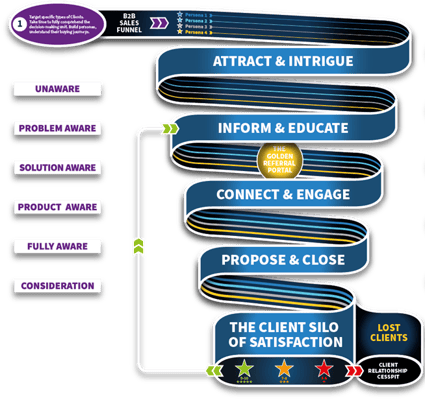8 Toxic Digital Marketing Pitfalls Manufacturers Fall For
95% of manufacturers invest in digital marketing but many fall victim to the same pitfalls time and time again. Unfortunately, there’s no magic bullet when it comes to marketing success. However, having worked with manufacturers for 20+ years, we’ve come to learn what the eight most common digital marketing mistakes are and how they can be avoided.
How do you know if you’re committing one of these ten costly sins? Often, you’ll be feeling symptoms such as not meeting sales targets, a lack of marketing results or not seeing ROI from your marketing spend.
These marketing mistakes are costing your manufacturing business money right now. So, let’s dive right in!
The top eight marketing mistakes manufacturers make
- Acquiring the wrong traffic
- Poorly Managed Paid Search
- Lack of Organic Visibility
- Weak Sales Messaging
- Competitive Intelligence
- Bad User Journeys
- You Have No Marketing Strategy
- You Don’t Have The Right Tech Stack
1. Acquiring the wrong traffic
If you’re acquiring the wrong traffic, you’re really getting yourself off on the wrong foot before you’ve even started. Google analytics may be telling you that top level metrics such as traffic, website sessions and pageviews are all looking great. However, looking at these stats in isolation can be dangerous and lead you to the wrong conclusions.
You need to be looking at these stats in relation to the length of time users spend on site, bounce rate and which pages users are visiting.
Obviously, it’s also important to keep your eyes on the prize too – you need to look at your website’s conversion rate and, if you have access to these metrics, how much revenue the website brings each month/year.
When it comes to organic traffic, targeting the wrong keywords is a common cause for. This often happens when targeting really broad, highly competitive keywords that don’t have the right intent behind them.
A prime example of this was found in a previous investigation for a potential client. The prospect was experiencing brilliant organic growth in terms of traffic, but this traffic had a high bounce rate and wasn’t generating enquiries as expected. In fact, during this time, organic search traffic had a bounce rate of 77%!
On investigating this further, we found that around one third of organic traffic was coming in on one erroneous blog that was for completely the wrong audience. The blog had a bounce rate of 95%!
The implications of this meant that while things look good on the surface with the increase of organic traffic, the prospect was attracting completely the wrong audience!
2. Poorly managed paid search
Paid search has the potential to be both a reliable source of hot leads and an endless black hole for your marketing budget. Managed in the right way, you can get in front of prospects when they’re ready to buy. Managed wrong, and you can say goodbye to your marketing budget with very little return…
Not managing your paid search account properly can cost you serious money.
In a recent investigation we found a client to be sponsoring keywords that were very broad meaning they were being found for irrelevant search terms.
This resulted in them spending 52% of their paid search budget on keywords that just weren’t converting, costing them almost £21,000! Imagine if we hadn’t spotted this and they’d spent an additional £21,000?!
In another example, poorly segmented keywords led a client to spending 77% of their paid search budget on terms that were not relevant to the landing page. This was obviously a huge waste of money for the but also meant the user journey was confusing – not great for brand image!
There are many indicators to a paid search account being poorly managed (we could do a whole blog on this subject alone)! The following are just a few of the most common ones we see that lead to wasted budget, poor results and damaged user journeys:
- Targeting the wrong keywords
- Not taking into consideration the intent of the searches you are targeting
- Not optimising ads for device, location and geography
- Not matching search queries to ads and ads to landing pages
- Poor landing page performance
- Poor conversion tracking
- Not reviewing ads from your competitors.
3. Lack of organic visibility
In my experience, most manufacturing organisations suffer with relying on their brand name to generate traffic. There’s a fine line between high levels of brand awareness and an overreliance on the brand name, meaning you struggle to get in front of new audiences. The latter means users need to know your business’ name in order to find you online.
Why does this matter?
Most manufacturers we work with are highly reliant on their brand name, receiving anything between 50-90% of their organic traffic from brand related search terms.
This means lead generation is limited to those who already know your business.
Non-branded search is where you can reach new users and incrementally grow organic traffic.
How? Content, content and more content. But what kind of content?
You need to target prospects with top of funnel content to answer their questions and educate them early on in the buying process. This allows the prospect to build trust with you and positions you as a reliable source of information so when they are ready to make a purchase decision, they know who to turn to!

An example of this in action can be seen in the below. This time one year ago, our client was receiving 265k impressions from searches that did not include the brand name.

Through generating relevant content that answers common questions from the target audience, we’ve been able to help them achieve:
- a 260% increase in impressions without the brand name.
- a 112% increase in non-branded clicks!
This means they’re getting in front of a whole lot more people within their target market!
4. Weak sales messaging
Having spoken to many manufacturing businesses, we know that creating strong sales messaging is a common challenge. However, in a niche, competitive marketplace you really can’t afford to have poor sales messaging. It’s what draws your users in…
You spend time and money driving people to your online storefront. Don’t turn them away by showing a lack of understanding of their challenges, or even worse, by only talking about yourself! While your website users need to know who you are and what you do, their main priority is understanding how you can help them.
That means you need to have detailed marketing personas. THIS IS NOT A TICK BOX EXERCISE! It is crucial to your entire marketing strategy and pivotal to having great sales messaging.
Your buyer personas should outline:
- Stresses and challenges
- Common objections
- Needs
- Buying triggers
- Channel usage
They should also include:
- Where they go for information
- What objections they often have
- Information on what stops them from buying
- Who they answer to
- What their buyer journey looks like
Without this information you simply can’t create strong sales messaging. You’ll be lost in a sea of businesses who all look similar. You need to be different.
5. Inadequate competitive intelligence
In business, two people will decide your success – the customer and the competition.
78% of B2B buyers start their journey with a Google search. Will they find your business? Will they find your competitors? These are key questions. If your prospects are finding your competition before you, you have little to no chance of even losing the deal, let alone winning it!
There are two mistakes businesses often make when it comes to competitive intelligence.
- They take no interest in what their competition are doing to attract and win leads
- They don’t fully understand who their online competition are.
This means:
- You miss out on leads because you don’t show up (your competitors say “thanks”, by the way).
- Your messaging blends in with everyone else’s.
- You’re blind to growth opportunities.
It’s key that you understand what your direct competitors are doing with their marketing, but also what indirect competitors are doing. These are the companies that don’t offer the same products and services you do but do compete for similar keywords and audience!
6. Broken user journeys
Similarly to poor sales messaging, bad user journeys can be a huge point of weakness for any business driving traffic to a website.
This is what makes me shout at my computer, much to my colleagues’ annoyance…
In this world, your website is your best salesperson. But if it’s pointing people off to the wrong pages or using confusing language, you could be missing out on lots of opportunities!
How much could turning away 30% of your audience cost you?
How could converting just 10% more website users into customers impact your business?
User journeys have the power to make or break the success of a website. And I’m not just talking about how a website looks… Common user journey issues include:
- Lack of mobile optimisation
- Slow load speed
- Overwhelming menus
- Buried content
- Unclear CTAs
- Making the user work too hard.
Data holds the answer. Every change made on your website should be based on data and reviewed and tested again and again.
7. You have no marketing strategy
Almost half of SMB owners have not formalised a marketing strategy or goals. Those that have, spend such a small amount of time talking about it that it may as well not be there, and that leads to the vast majority (90%) of organisations failing to execute their strategies successfully.
This is a particular problem in the manufacturing sector with 27% of manufacturing firms stating a lack of strategy to be their top marketing challenge. I think it’s likely A LOT higher than this.
The implications of this are huge, and leads to:
- A lack of focus
- Things don’t get done
- Lack of differentiation
- No plan to overcome challenges
- No clear objectives
- No reporting
Success is a journey. You need to know where you’re going. You need a plan and the tech to support it to get there. Take a look at this blog for developing a marketing strategy for your manufacturing business.
8. Tech Stack
Sales and marketing tech stacks are often overlooked when it comes to manufacturing organisations. It’s common for the focus to be on investing in technology to help with the production of products. Often, the sales and marketing production line is comparatively neglected.
With the B2B sales landscape as it is now, your tech stack is increasingly important and can be the difference between consistent, measurable results and well… nothing!
B2B buyers spend as little as 17% of their buying journey meeting with potential suppliers. You need to supply prospects with the information they’re looking for 24/7/365. You also need to report on your marketing spend and to do that, you need one centralised system for all of your data.
Not having the right tech in place allows all sorts of marketing issues to fester including:
- Poor lead generation and tracking
- Lengthened sales cycles
- Gaps in pipeline
- Misaligned sales and marketing teams
- Poor customer relationship management
- Unclear ROI reporting
- No visibility of how you fare against competitors.
To plan a route to optimum visibility, you need to know:
- How many leads you generate each month
- Where those leads come from
- How much it costs you to generate a lead
- Lead to opportunity conversion rates
- Opportunity to sales conversion rates
- Average sale value
- Customer lifetime value
- ROI generated from marketing spend.
As a baseline, the modern marketer’s toolkit should consist of:
- CRM
- Marketing automation platform
- Social manager
- Pipeline manager
- Ads manager
- Website + landing page builder
HubSpot is an excellent tool that takes cares of all of this in place for you. You can find out more about HubSpot for manufacturers here.
Recap
So, to recap, the top eight marketing pitfalls for manufacturers are:
- Acquiring the wrong traffic
- No SEO Strategy
- Weak Sales Messaging
- Lack of Organic Visibility
- Poorly Managed Paid Search
- Bad User Journeys
- You Have No Marketing Strategy
- You Don’t Have The Right Tech Stack
There’s no magic for digital marketing success. However, if you take the following advice, you’ll set a solid foundation for yourself:
- Always have the prospect in mind
- Do your research
- Make data your best friend
- Don’t make subjective decisions
- Test, test and test again
- Don’t sweat the small stuff
- Get a third-party view.






